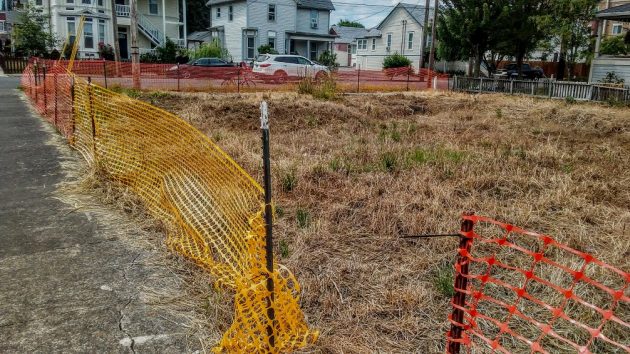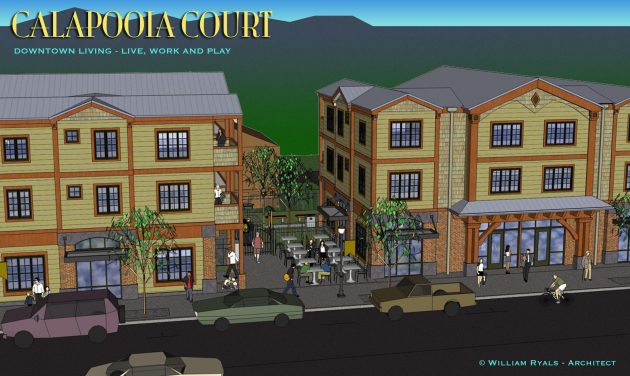
The lot at Fourth and Calapooia remains vacant while the land-use approval process unfolds.
Calapooia Court, the plan for two buildings in Albany’s Monteith Historic District, has cleared one hurdle but is not yet approved for construction.
The Albany Landmarks Commission rejected the project as too big and too tall for the neighborhood on May 19. The property owners, Mark and Tina Siegner, appealed to the city council. The council overturned Landmarks and approved the application on June 24.
On Wednesday night the council voted 5-1, with Dick Olsen opposed, to adopt findings to back up its approval of the project, and the city’s planning division mailed a “notice of decision” in the case the following day, Thursday.
This mailing starts a 21-day period during which people who participated in the hearings may appeal the council decision to the state Land Use Board of Appeals. The last day to file an appeal is July 30.
Friends of Historic Albany, sharply critical of the project and of the council’s handling of the case, said on its Facebook page it was considering how to proceed.
In addition, the planning staff said the project also needs approval of a site plan before the owners can apply for a building permit. The city said earlier that a site plan had been submitted, but how or when the review was being handled was not clear.
One of these days construction on that corner may start. But clearly it won’t be right away. (hh)

Architect Bill Ryals’ vision of the two buildings proposed at Calapooia and Fourth.



Parking is going to be a ridiculous problem that I’ve seen no one care about
You assume all/most residents will have cars. That may be a situation that won’t exist, depending on the “type” of tenants.
Bill,
“type” of tenants.
I don’t understand the inference of this statement. This is a very high end builder, he’s responsible for some of the nicest homes in Albany. This is probably going to be in the running for the most desirable rental inventory in the city (and most expensive), rental does not automatically mean a negative. I understand the desire to keep the existing historical housing and also when you buy downtown your are essentially buying into an HOA. But there just wasn’t a way to create a balance sheet that made keeping these houses possible, the only outcome was continued blight and since another URD funding round would seem to be toxic, the blight for this area would just go on and on and against everything CARA was trying to accomplish. Current developers have to increase the number of units per sq. footage of land in order to make projects feasible (the current projection is 19 per acre at this point), you can’t have line items in family budgets of $175m public sector obligations, $180m school bonds and not have cluster developments, you’re simply trading public services for increases in density, it’s just the way this works. You want large areas of EFU, then you have to embrace higher density on what is left to build on. Plus you now have large amounts of prime real estate downtown that is off the books, labeled non-profit, and is no longer paying the bills it takes to service it, that obligation falls on those that are left paying.
I guess you could make the community undesirable to live in, that’s one of the reasons Salem is so heavily involved in development of local communities right now, the tactic of “make it miserable to develop so no one tries” (a favorite of Corvallis) has now brought Salem into the picture as the final centralized planning authority for development. I’ve seen some developers say this is what I’m going to build because this is what Salem wants, they are basically telling local communities you no longer have a say. I think that’s the warning Councilor Johnson is trying to point out, there’s not a lot of opportunity for younger residents, a community that is relying on government subsides and senior fixed incomes to survive is not going to do well in the end. The recent elimination of another 75 good paying free market employment opportunities right here in Albany should be an eye opener.
???? so many Qs Are you a or do you work for a developer? I laugh if you do or Are……LOL it started with “tenants”!
“LOL it started with “tenants””
Yes it did, they are a major piece of the local economic engine, without other major revenue streams, they not only cover a large percentage of the property tax and bond liability but also the franchise fees. No, not associated with any developers, just an investor in the community, trying to figure out moves and counter moves, every time government makes a move or intervenes in the economy, it causes a whole set of unintended consequences, some good, some really bad. Developers are only trying to react to these moves, for instance the developer downtown is using mixed use to try and offset the number of residential units required to balance his investment sheet and make it worthwhile doing the project. He doesn’t have the acres to build at 19 units per, he’s taking a leap of faith commercial can make up the difference, that’s his market risk. You’ll notice Wednesday, another developer/store owner is going to try a different path, using CARA subsidizes, and I hope, low, not high, cost interest leverage (and his own treasure). I assume he’s using positive revenue projections based on historical personal sales and future rental revenue and not attempting to develop tax offsets for revenue from another project, another strategy we have seen under CARA. It would be interesting to look at his numbers to determine viability, I assume CARA will be interested in seeing this. There’s a whole set of government intervention that muddies the waters with something like this. Does he get to use his current AV under the historical tax freeze, paying tax at the current level of non-improvement? Does that count as a double subsidy, using public money paying for improvements and not receiving any tax revenue as the backer of a fixed long term improvement liability? You really have to look at the financials to determine if it”s a good investment or not, or the real question, how must risk is involved. I see way too much of the mythical movie concept, “If you build it, they will come”, or expenses are fixed, that’s the way it is, just increase revenue projections to cover.
Steve Reynolds-
For God’s sake! All I meant is that some tenants simply may not own cars because they may not need one.
What’s YOUR problem?
OK, no problem.
.